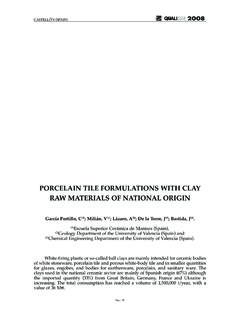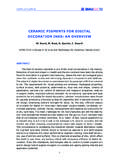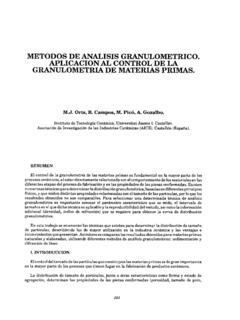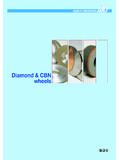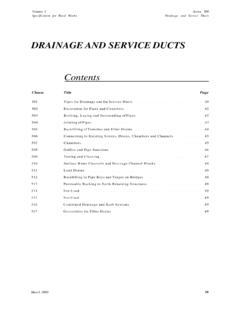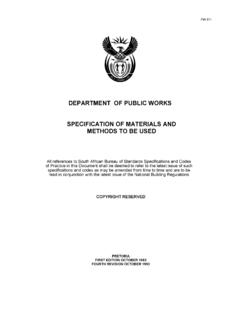Transcription of BRITISH STANDARDSAND CODES OF PRACTICE FORTHE …
1 BRITISH STANDARDS AND CODES OF. PRACTICE FOR THE installation OF. WALL & FLOOR TILES. by William L. Walters and Roy Harrison (Great Britain). - in physical chemistry from the University of Liverpool. Fellow of the Royal Society of Chemistry and Chartered Chemist. Fellow if the Institute of Ceramics. Senior Consultant, Tile Research Section, BRITISH Ceramic Research Ltd. Chairman of the BRITISH Standards Committee for CODES of PRACTICE and all relevant BS, and ISO Committees dealing with tiles and tile adhesives. Vice - president of the Institute of Ceramics. SYNOPSIS. The need for standardisation and the importance of adhering to recommended PRACTICE has been recognised as essential in the UK for many years.
2 As new systems of fixing were proposed it was imperative that research and development was undertaken to assess and possibly modify the new system. As a result Ceram Research has been closely involved in the development of CODES of PRACTICE and standards work from the outset and co-author Roy Harrison sat on and chaired many BS. committees. A comprehensive series of CODES of PRACTICE is now established. Firstly in the form ofBS5385 parts 1-5 and secondly as a series of site instructions for clerks of works as the BS8000 series. The separate parts deal with internal wall tiling, external wall tiling, internal and external floor tiling, non-ceramic cladding ego terrazzo, natural stone etc.
3 And tiling in special conditions ego swimming pools. This part is particularly important. Selection of appropriate tiles is critical particularly in special conditions and Ceram Research suggest that some categories of tiles are suitable for walls and floors only. Having been involved in the research of many aspects of tile fixing in the development of the standards and with a wealth of experience of tiling consultancies, Ceram Research is well placed to undertake research into new fixing systems. 43. INTRODUCTION. The UK implemented the European Standard for ceramic tiles as the parts achieved final acceptance in 1983 and 1984. Prior to that there were two standards, one for porous body glazed wall tiles, BS1281, and one for floor tiles BS1286.
4 The latter included both single-extruded tiles, known as quarries, and dust-pressed tiles. There was not a BS for extruded split tiles. There has also traditionally been recognition of one other type of glazed tile, manufactured principally for tiled surrounds. For many years the latter were mainly for coal fires and they were made by placing tiles face down and at the sides of moulds into which dense concrete was poured. The tiled surrounds would typically weigh 150 kg and the tiles were required to be highly decoratively glazed but of higher strength than typical wall tiles. Nowadays a high proportion of tiled surrounds enclose radiant gas or electric fires and the strength requirement is not so critical.
5 These are made oflightweight concrete or wooden boards. The casting and fixing techniques for tiled surrounds have never been incorporated in BS CODES of PRACTICE but, after an extensive research programme, guidelines were established by Ceram Research. The first code of PRACTICE for ceramic tiling was for floors and this was published in 1959. The demand for it arose from a number of pop-up failures; cases where tiles or tiles plus bedding mortar had popped-up as a result of the contraction of the base concrete. There had been a massive increase in the use of concrete bases and there was also pressure to achieve faster building completions. One of the main provisions of the flooring code therefore was to introduce the separating layer technique which enables base shrinkage to be isolated from the tiles and their bedding mortar.
6 Two other types oftiles, neither of which form part ofthe European Standard, have to be mentioned for completeness. These are architectural terracotta, which is usually red or buff coloured and unglazed. This material is usually vitrified with a water absorption below 3%. The other is architectural faience tiles, not to be confused with earthenware tiles. Faience tiles have porous, coarse textured bodies, but they are always glazed. Both architectural terracotta and architectural faience tiles are made to size or oversize and fitted to specific positions. They are adhered and also cramped, that is they have metal fixings. The main application is externally and they are therefore frost resistant.
7 They are also usually large sized, typically up to 600 mm facial dimension. 1. OVERALL PLAN OF CODES OF PRACTICE . There are two series of CODES . The main series is in five parts: BRITISH Standard. Wall and floor tiling BS5385. Part 1.' code of PRACTICE for the design and installation of internal ceramic wall tiling and mosaics in normal conditions. Part 2. code of PRACTICE for the design and installation of external ceramic wall tiling and mosaics (including terracotta and faience tiles). Part 3. code of PRACTICE for the design and installation of ceramic floor tiles and mosaics. Part 4. code of PRACTICE for ceramic tiling and mosaics in specific conditions. Part 5. code of PRACTICE for the design and installation of terrazzo tile and slab, natural stone and composition block floorings.
8 Part 5 Deals with products which are designed and installed with many similarities to ceramic tiling. They are often treated as alternatives and the choice between them is frequently made aesthetically. There will however be no further discussion on them in this paper. 44. Whereas there are separate CODES of PRACTICE for internal and external wall tiling there is only one code of PRACTICE (part 3) for flooring. The BRITISH winter climate is amongst the most severe in Europe and we have a very high rainfall. As a result particular care has to be taken with external tiling. The second series consists oftwo parts only within a broad series on instruction which are based on the main series but reduced to sets of site instructions and with the minimum ofexplanations.
9 They are intended for clerks of works, who direct day-to-day work on site, and the operatives. The two which deal with ceramic tiling and related products are: Workmanship on building sites BS8000. Part 11. code of PRACTICE for wall and floor tiling Section Ceramic tiles, terrazzo tiles and mosaics. Section Natural stone tiles. Thus the BRITISH CODES of PRACTICE encompass general and detailed recommendations as well as site instructions and also deal with hard products other than ceramic tiles which are fixed in similar ways. Revision of the main series, BS5385, has recently been completed but one minor addition has been proposed for part 1. This will add specific requirements for fixing natural stone tiles internally with adhesives.
10 Table 1. Layout of BS5385, Parts 1, 2 and 3 which deal with ceramic tile fixing Main Section Examples of Type of information 1. General Definitions Exchange of information Time schedules 2. Materials Tiles Sand Fixing materials, including grouts, Reinforcement. 45. Table 1. cont'd. Layout of BS5385, Parts 1, 2 and 3 which deal with ceramic tile fixing Main SectiQn Examples Qf Type of information 3. Design Alignment Bases and backgrounds Rendering and screeds Conditions of use. Movement joints. 4. Application of Surface preparation tiles: methods and Setting out materials. Bedding methods Tile joint treatment Grouting procedure 5. Application of Setting out mosaics: methods Preparation of mosaics and materials Bedding methods Application Grouting procedure Glass Qr natural stone mosaics 46.
